Introduction
The recent devastating fire that broke out in Mumbai’s Goregaon West shook the entire city, leaving many horrified and concerned about the safety measures in place. The incident not only caused immense damage to property but also raised critical questions about fire safety protocols, emergency response, and building regulations in one of India’s most populous cities. In this article, we will delve into the details of the fire incident, analyze the factors that contributed to its severity, and explore the broader implications for urban safety and disaster management.
The Goregaon West Fire: What Happened?
On a fateful evening, a massive fire engulfed a prominent commercial building in Goregaon West, Mumbai, spreading rapidly due to combustible materials and inadequate fire suppression systems. The blaze, fueled by a combination of factors such as flammable substances, congested spaces, and lack of proper ventilation, quickly escalated into a major inferno that posed a significant challenge to the firefighting teams.
Factors Contributing to the Severity of the Fire
Several key factors exacerbated the intensity and spread of the fire in Goregaon West. Inadequate fire safety measures within the premises, including blocked exit routes, faulty fire alarms, and absence of sprinkler systems, hampered the swift evacuation of occupants and containment of the blaze. The presence of flammable materials in the building further fueled the fire, creating a volatile environment that was difficult to control. Additionally, poor urban planning that led to overcrowding and congestion in the area hindered the access of fire trucks and emergency vehicles, delaying the response time and exacerbating the situation.
Lessons Learned and Recommendations for the Future
The tragic incident in Goregaon West underscores the pressing need for comprehensive reform in fire safety regulations, emergency preparedness, and urban infrastructure planning. To prevent similar disasters in the future, authorities must prioritize the following measures:
-
Strict Enforcement of Building Codes: Stringent regulations mandating the installation of fire alarms, sprinkler systems, and emergency exits in all commercial buildings should be enforced without exception.
-
Regular Inspections and Audits: Routine checks and audits of commercial structures to ensure compliance with fire safety standards and the elimination of hazards are essential to preempt potential disasters.
-
Public Awareness and Training: Educating occupants and employees about fire safety protocols, evacuation procedures, and preventive measures can enhance preparedness and reduce casualties in emergencies.
-
Investment in Firefighting Infrastructure: Adequate funding and resources must be allocated to fire departments to enhance their capacity for swift response and effective containment of fires.
-
Urban Planning Reforms: Sustainable urban planning practices that prioritize safety, accessibility, and adequate spacing between buildings can mitigate the risks associated with rapid fire spread in densely populated areas.
Conclusion
The fire outbreak in Goregaon West serves as a stark reminder of the critical importance of robust fire safety measures, emergency response mechanisms, and urban planning strategies in safeguarding communities from disasters. By learning from the lapses that led to this tragic event and implementing proactive measures to enhance resilience, cities can strive towards creating safer environments for their residents and businesses.
Frequently Asked Questions (FAQs)
- What should I do in case of a fire emergency in a building?
- Remain calm and alert.
- Immediately evacuate the building using the closest exit.
- Do not use elevators; use stairs instead.
-
Move away from the building and call emergency services.
-
How can I assess the fire safety of a building I work or live in?
- Check for functional fire alarms and emergency lighting.
- Ensure clear exit paths and unobstructed doors.
-
Inquire about fire drill procedures and evacuation plans.
-
What are some common causes of fires in commercial buildings?
- Electrical faults and short circuits.
- Overloaded power sockets.
- Improper storage of flammable materials.
-
Arson or deliberate acts of vandalism.
-
Why are sprinkler systems important in fire safety?
- Sprinkler systems can suppress fires effectively.
- They provide early intervention before the arrival of firefighters.
-
Help in containing the spread of fire and minimizing damage.
-
How can communities support firefighting efforts during emergencies?
- Clear access roads and parking areas for fire trucks.
- Follow instructions from emergency responders.
- Provide accurate information about the situation to authorities.
- Volunteer or donate to local fire departments for equipment and training.
